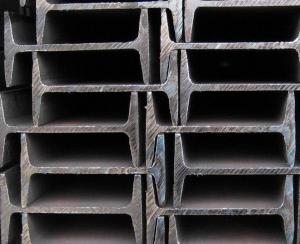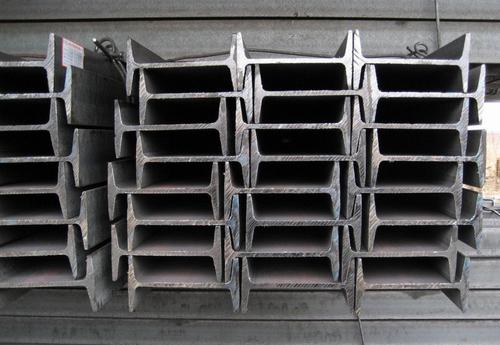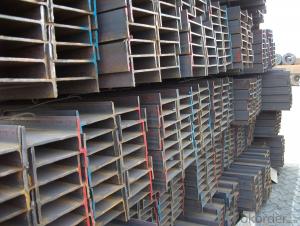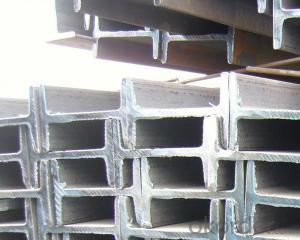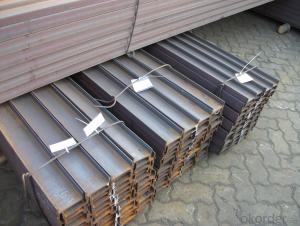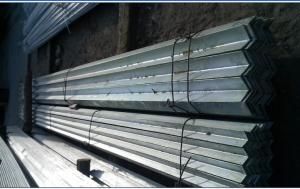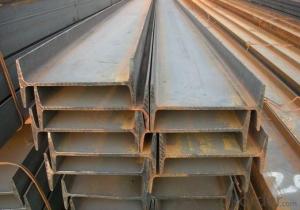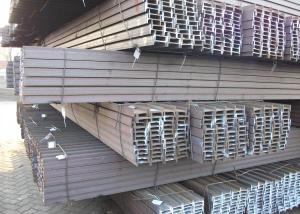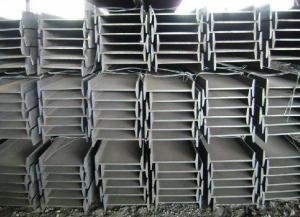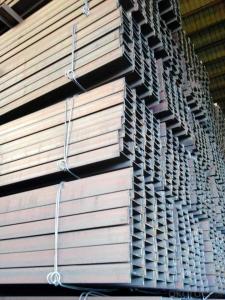High quality IPE with Good Price and Great Quality
- Loading Port:
- Tianjin
- Payment Terms:
- TT OR LC
- Min Order Qty:
- 25 m.t.
- Supply Capability:
- 10000 m.t./month
OKorder Service Pledge
OKorder Financial Service
You Might Also Like
Product Description:
OKorder is offering high quality Hot Rolled Steel I-Beams at great prices with worldwide shipping. Our supplier is a world-class manufacturer of steel, with our products utilized the world over. OKorder annually supplies products to European, North American and Asian markets. We provide quotations within 24 hours of receiving an inquiry and guarantee competitive prices.
Product Applications:
1. Supporting members, most commonly in the house raising industry to strengthen timber bears under houses. Transmission line towers, etc
2. Prefabricated structure
3. Medium scale bridges
4. It is widely used in various building structures and engineering structures such as roof beams, bridges, transmission towers, hoisting machinery and transport machinery, ships, industrial furnaces, reaction tower, container frame and warehouse etc.
Product Advantages:
OKorder's Steel I-Beams are durable, strong, and resist corrosion.
Main Product Features:
· Premium quality
· Prompt delivery & seaworthy packing (30 days after receiving deposit)
· Corrosion resistance
· Can be recycled and reused
· Mill test certification
· Professional Service
· Competitive pricing
Product Specifications:
1. Invoicing on theoretical weight or actual weight as customer request
2. Standard: EN10025, GB Standard, ASTM
3. Grade: Q235B, Q345B, SS400, ASTM A36, S235JR, S275JR
4. Length: 5.8M, 6M, 9M, 12M as following table
5. Sizes: 80mm-270mm
Dimensions(mm) | |||||
h | b | s | t | Mass Kg/m | |
IPE80 | 80 | 46 | 3.80 | 5.20 | 6.00 |
IPE100 | 100 | 55 | 4.10 | 5.70 | 8.10 |
IPE120 | 120 | 64 | 4.80 | 6.30 | 10.40 |
IPE140 | 140 | 73 | 4.70 | 6.90 | 12.90 |
IPE160 | 160 | 82 | 5.00 | 7.40 | 15.80 |
IPE180 | 180 | 91 | 5.30 | 8.00 | 18.80 |
IPE200 | 200 | 100 | 5.60 | 8.50 | 22.40 |
IPE220 | 220 | 110 | 5.90 | 9.20 | 26.20 |
IPE240 | 240 | 120 | 6.20 | 9.80 | 30.70 |
IPE270 | 270 | 135 | 6.60 | 10.20 | 36.10 |
FAQ:
Q1: Why buy Materials & Equipment from OKorder.com?
A1: All products offered byOKorder.com are carefully selected from China's most reliable manufacturing enterprises. Through its ISO certifications, OKorder.com adheres to the highest standards and a commitment to supply chain safety and customer satisfaction.
Q2: How do we guarantee the quality of our products?
A2: We have established an advanced quality management system which conducts strict quality tests at every step, from raw materials to the final product. At the same time, we provide extensive follow-up service assurances as required.
Q3: How soon can we receive the product after purchase?
A3: Within three days of placing an order, we will begin production. The specific shipping date is dependent upon international and government factors, but is typically 7 to 10 workdays.
Images:
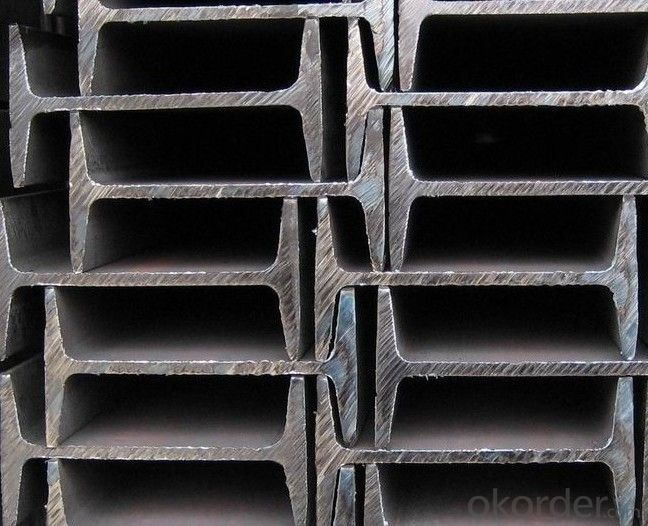

- Q: What are the different types of steel connections used for I-beams in renovations?
- There are several different types of steel connections that are commonly used for I-beams in renovations. These connections are designed to provide structural support and stability to the I-beams, ensuring that they can effectively bear the weight and loads placed upon them. One common type of steel connection used in renovations is the bolted connection. This involves using bolts and nuts to secure the I-beam to other structural elements, such as columns, beams, or plates. Bolted connections are highly versatile and can be easily adjusted or modified if needed. They provide a strong and reliable connection, making them suitable for a wide range of renovation projects. Another type of steel connection is the welded connection. This involves welding the I-beam to other steel components, creating a permanent and seamless joint. Welded connections offer excellent strength and rigidity, making them ideal for heavy-duty applications. However, it is important to ensure proper welding techniques are used to maintain the integrity of the connection. In addition to bolted and welded connections, there are also specialized steel connections available for specific renovation scenarios. For instance, moment connections are used when there is a need to resist rotational forces or moments. These connections are designed to provide extra rigidity and stability to the I-beams, preventing any unwanted movement or deflection. Moreover, there are also eccentric connections that are used when the center of gravity of the I-beam does not align perfectly with the connecting element. These connections are designed to accommodate this eccentricity and ensure a secure and stable connection. Overall, the choice of steel connection for I-beams in renovations will depend on factors such as the load requirements, structural design, and specific project constraints. Consulting with a structural engineer or construction professional is essential to determine the most suitable steel connection type for a particular renovation project.
- Q: Can steel I-beams be used for industrial warehouses or storage facilities?
- Yes, steel I-beams can be used for industrial warehouses or storage facilities. Steel I-beams are commonly used in the construction of such structures due to their strength, durability, and load-bearing capabilities. They provide structural support and can withstand heavy loads, making them suitable for large-scale warehouses or storage facilities. Additionally, steel I-beams are versatile and can be customized to meet specific design requirements, making them a popular choice in the industrial construction industry.
- Q: 316 stainless steel from drilling, can I do it?
- Many stainless steel grades, different properties, and in the course of its development has gradually formed several categories. According to the organizational structure, divided into martensitic stainless steel (including stainless steel), ferritic stainless steel, austenitic stainless steel and austenitic and ferritic duplex stainless steel four categories; according to some characteristic elements of main chemical components in steel or steel in the classification, divided into chromium stainless steel, chromium nickel, stainless steel nickel chromium molybdenum stainless steel and low carbon steel, stainless steel, high purity and high molybdenum stainless steel etc.;
- Q: How do steel I-beams contribute to the overall energy efficiency of a building?
- Steel I-beams contribute to the overall energy efficiency of a building by providing structural support and reducing the need for excessive material usage. Their strength and durability allow for the construction of larger spans, enabling open floor plans and maximizing natural light, which in turn reduces the reliance on artificial lighting and enhances energy efficiency. Additionally, steel I-beams have excellent thermal conductivity, facilitating efficient heating and cooling distribution throughout the building, thus reducing energy consumption and promoting sustainability.
- Q: Are steel I-beams suitable for earthquake-prone areas?
- Steel I-beams are commonly used in construction due to their strength and durability, which makes them a suitable choice for earthquake-prone areas. Steel has excellent tensile and compressive strength, allowing it to withstand the lateral forces generated during an earthquake. Additionally, I-beams have a high load-bearing capacity, making them capable of supporting heavy loads and resisting structural damage. Steel I-beams also have inherent flexibility, which is crucial in earthquake-prone areas. During an earthquake, the ground shakes and moves, causing buildings to sway. The flexibility of steel I-beams allows them to absorb and distribute the seismic forces, reducing the risk of structural failure. This flexibility also enables buildings to undergo elastic deformation, meaning they can deform temporarily and return to their original shape after the earthquake subsides. Furthermore, steel is a material that can be easily fabricated and assembled, allowing for efficient construction in earthquake-prone areas. This flexibility in design and construction enables engineers to incorporate seismic-resistant measures, such as base isolation or dampers, to enhance the building's earthquake resilience. However, it is important to note that the suitability of steel I-beams for earthquake-prone areas is not solely dependent on their material properties. Proper design and construction practices, adhering to seismic codes and regulations, are essential to ensure the structural integrity of the building. Engineering considerations, such as the building's height, weight distribution, and foundation design, should also be taken into account to withstand seismic events effectively. In conclusion, steel I-beams are suitable for earthquake-prone areas due to their strength, flexibility, and load-bearing capacity. However, proper design, construction, and adherence to seismic codes are crucial to ensure the overall safety and resilience of the building in such areas.
- Q: Can steel I-beams be used in aviation or aerospace renovation projects?
- Yes, steel I-beams can be used in aviation or aerospace renovation projects. They are commonly used in aircraft hangars, aerospace manufacturing facilities, and other aerospace structures due to their high strength and load-bearing capabilities. Steel I-beams provide structural support and stability, making them suitable for various applications in aviation and aerospace projects.
- Q: How do steel I-beams perform in high wind areas?
- Steel I-beams are a commonly used structural component in buildings and bridges, known for their strength and durability. When it comes to high wind areas, steel I-beams perform exceptionally well due to their inherent properties. Firstly, steel is a very strong material, which allows I-beams to withstand high wind forces. The I-shaped design of the beam provides excellent load-bearing capacity, making it highly resistant to bending or buckling under strong winds. This structural integrity ensures that the building or bridge remains stable and minimizes the risk of collapse or damage. Moreover, steel I-beams have a high stiffness-to-weight ratio, meaning they are lightweight yet extremely rigid. This characteristic is crucial in high wind areas as it helps to minimize the deflection and sway caused by wind gusts. The stiffness of steel I-beams reduces the potential for vibrations, ensuring that the structure remains stable even during severe wind storms. Additionally, steel is a highly ductile material, which means it can absorb and dissipate energy effectively. In the event of high winds, the flexibility of steel I-beams allows them to absorb the wind load and distribute it throughout the structure. This prevents localized concentration of forces and helps to maintain the overall stability of the building or bridge. Furthermore, steel I-beams can be designed and engineered to meet specific wind load requirements. By considering factors such as wind speed, direction, and the location of the structure, engineers can determine the appropriate size and spacing of I-beams to ensure optimal performance in high wind areas. This customization ensures that the structure is adequately protected against wind-induced forces. In conclusion, steel I-beams are highly effective in high wind areas due to their strength, stiffness, and ductility. Their ability to resist bending or buckling, their lightweight yet rigid nature, and their capacity to absorb and distribute wind load make them an ideal choice for structural applications in areas prone to strong winds.
- Q: Own attic, choose I-beam or channel?
- Channel steel: used for construction and mechanical use of carbon structural steel, is a complex cross-section of steel.Channel characteristics:Channel steel can change the structure of the building, and save construction materials.If the channel is constructed, it will be quick enough to be ready for use without waiting.Inadequate: it is an attic made of channel steel. When people move on it, there will be a certain shake. The smaller the channel gauge, the greater the sloshing. The larger the channel gauge, the smaller the shaking
- Q: What are the different types of steel surface treatments available for I-beams?
- Different surface treatments are available for I-beams, each with their own advantages and uses. 1. Hot-dip galvanizing is a widely used method that involves immersing the I-beam in molten zinc. The zinc coating provides excellent resistance to corrosion, making it ideal for outdoor applications. It also acts as a barrier against moisture and physical damage. 2. Powder coating is a process where a dry powder is applied to the surface of the I-beam and then heated and cured to create a durable and visually appealing finish. Powder coating offers a wide range of colors and textures, making it popular for architectural and aesthetic purposes. 3. Epoxy coating is a two-part system consisting of a resin and a hardener. It offers excellent resistance to chemicals and corrosion, making it suitable for industrial settings where the I-beams may be exposed to harsh environments or chemicals. 4. Paint coating is a traditional method where paint is applied to the surface of the I-beam. While it provides some protection against corrosion, it is generally less durable compared to other surface treatments. Paint coatings are often used for indoor applications or when aesthetics are the main concern. 5. Shot blasting is a mechanical treatment that involves propelling small steel shots at high speeds to remove rust, scale, and other contaminants from the surface of the I-beam. This process creates a clean and rough surface, allowing for better adhesion of subsequent coatings or paints. When selecting a steel surface treatment for I-beams, it is important to consider the specific requirements and environmental conditions. Seeking advice from a professional or a steel manufacturer can help determine the most suitable treatment for a particular application.
- Q: Can steel I-beams be used for solar panel mounting systems?
- Yes, steel I-beams can be used for solar panel mounting systems. Steel I-beams are commonly used in construction due to their strength and durability. They provide a sturdy framework for mounting solar panels and can withstand the weight and forces exerted by the panels and wind. Additionally, steel I-beams can be easily customized to fit specific project requirements, making them a versatile choice for solar panel mounting systems. However, it is important to ensure that the I-beams are properly designed and installed to meet the specific load requirements of the solar panels and to comply with local building codes and regulations.
Send your message to us
High quality IPE with Good Price and Great Quality
- Loading Port:
- Tianjin
- Payment Terms:
- TT OR LC
- Min Order Qty:
- 25 m.t.
- Supply Capability:
- 10000 m.t./month
OKorder Service Pledge
OKorder Financial Service
Similar products
Hot products
Hot Searches
Related keywords


